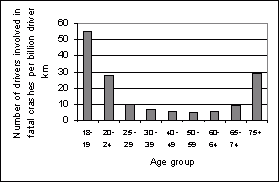Older drivers have a relatively high fatality rate. Data from the Netherlands illustrates this. Taking the distances travelled into account, the fatality rate for car drivers is more than five times higher for the 75 years and older than for the average for all ages. That of the 65 to 74-year-olds is much lower. However, other means of transport are not safer. The fatality rate is particularly high for older cyclists. The rate is about 12 times higher for the 75 years and older than for 'the average cyclist'. Compared with the fit group of 30 to 49-year-olds, the difference is even larger:
|   | Pedestrians | Cyclists | Car drivers | Car passengers | All transport modes |
|---|---|---|---|---|---|
| 20 - 24 | 25 | 10 | 15 | 8 | 10 |
| 30-49 | 18 | 7 | 2 | 2 | 4 |
| 60 - 64 | 29 | 18 | 3 | 2 | 5 |
| 65 - 74 | 44 | 37 | 6 | 5 | 10 |
| All 75+ | 191 | 174 | 22 | 12 | 39 |
| All ages | 32 | 14 | 4 | 3 | 6 |
Fatality rate: traffic fatalities per billion kilometres travelled, by age and mode of transport, Netherlands (1999-2003) Source: SWOV/Transport Research Centre, CBS.
Unfortunately, cross-national comparisons at this level of detail (fatality rate by age and mode of transport) are not possible. The international databases that contain crash data of several European countries do not include data on fatalities per means of transport per age group. The data for the Netherlands, however, is comparable to that of the other European countries, although the number of pedestrian fatalities seems to be somewhat lower than in other countries [81]. Cross-national comparisons of the number of fatalities and of fatality rates for all road users aged 65 years and above (regardless of means of transport) can be found in SafetyNet's Traffic Safety Basic Facts on The Elderly.
High fatality rates can be caused either by higher crash rates or by greater fragility. The fragility of a group of road users is reflected in the difference between their fatality rate and injury rate, but also in their fatality ratio: the percentage of fatalities in the total number of casualties.
Fatality rate versus injury rate for different age groups
Older drivers have the second highest fatality rate. Only the youngest group of drivers (18- and 19-year olds) has a higher fatality rate. The figure on the left shows the well-known U-shape: fatality rates of the young drivers are high, after which the rate declines to a minimum for drivers of the age of 40-60 years. Then it increases again, to a maximum for those aged 75 and older. The injury rates, depicted in the figure on the right, also show a U-shape, but this one levels off on the right-hand side. Whereas young drivers (18-24 years old) have a relatively high injury rate as well as a high fatality rate, the injury rate for older drivers is much lower than their fatality rate.
Fatality ratio: percentage of all injuries that are fatal, by age and means of transport, Netherlands (1999-2003) Source: SWOV/Transport Research Centre

